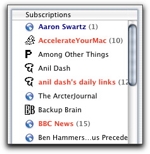9:00: Okay — the keynote stream is up and running. People are filing into their seats to the strains of Elvis over the sound system, and an announcement just came over the speakers giving a three minute warning and asking people to turn off any cell phones and pagers.
9:05: Steve’s onstage.
Over 60,000 viewers watching the QuickTime Webcast.
Talking about the ‘boilerplate’ text on Apple stationary/press releases — Apple ‘reinvented’ the computer in 1984 with the Macintosh — 20 years ago! Looking back on the state of tech in ’84, looking at the original Macintosh.
Laughs at a shot of Bill Gates in the original Mac brochure. ;)
The famous 1984 ad is being shown!
20th Anniversary posters featuring the hammer thrower from the 1984 ad are available at the Keynote.
Re: Mac OS X Panther — “Microsoft’s copying us again, it feels great!”
Going over the various features in Mac OS X.
Over 9.3 Million (40% of the installed Mac base) active Mac OS X users, should cross 10M this quarter. The fastest OS transition on record (3 years).
Final Cut Express 2 launches today. Based on Final Cut 4 tech. Up to 5 DV streams in realtime, effects and transitions in realtime, realtime audio, optimized for Panther and the G5. Richard Harris coming onstage to demo FCE2.
Office 2004 is being announced by Roz Ho from MS. Kris Barton is demoing the new features.
Word: New ‘Notebook View’ for taking notes. Quick Search function built into toolbar (similar to Apple’s built-in search functionality). Note Flags…do something that I can’t summarize easily. ;) Built-in audio recording for recording meetings when you can’t type fast enough.
Excel: Page Layout view in Excel, fully editable, but shows exactly how the spreadsheet will print — analagous to Word’s Layout view. Floating pallete for page formatting updates the Layout view live.
Entourage: Project Center (available in all Office programs, being demoed in Entourage). Looks to be a project manager that ties all various pieces together into a single ‘project’.
Roz again, announcing a Technology Gaurantee Program. Starting today, if you purchase MS Office X, you’ll get a free upgrade to Office 2004 when it’s released. She’s giving her thanks, and is done.
Steve’s back on stage, talking about the G5. Affirming again that the G5 is the roadmap for the future of Mac processors (maybe this will finally kill the ‘move to Intel’ rumors). Talking about Virginia Tech — apologizing for shipping the first 1,100 G5 dual processor machines to VT and “pissing off some other customers.” Comparing the top three supercomputers power and price, VT comes in at #3, over 10 terraflops for 5.2 million dollars. Showing a video of the VT supercomputer center.
Announcing the G5-based XServe!
1-U form factor. Single and dual 2.0 Ghz G5 processors. EEC memory up to 8 Gb. Up to 750 Gb storage. A couple other things I missed. All the usual ports. Ships with Panther Server 10.3 and an unlimited client license. 3 models: Server/2.0 Ghz/2999, Server/Dual 2.0 Ghz/3999, Compute Node/2.0 Ghz/2999.
Xserve RAID also updated. Going over the Xserve RAID specs. New features: up to 3.5 Terrabytes storage in a 3U rack. SFP Fibre Channel connectors. RAID set slicing. I have no idea what some of this means. On the fly RAID set expansion. Audience is applauding, these are probably good things. ;)
Xserve RAID certified for OS X. Win 2k3 Server, XP pro, and 2 versions of Linux. 3 versions of Xserve Raid (1, 1.75, and 3TB, works out to about \$3 per Gigabyte at the high end).
Moving to iTunes. 30M songs purchased since April 28, tens of millions of songs ahead of the competitors. Almost 1.9 million songs per week. Neilsen SoundScan puts iTMS at 70% of the online legal downloads. “Feels great to get above that 5%, doesn’t it?” The top spender on the iTMS has spent \$29,500! Over 50,000 AudioBooks sold since their introduction. Over 100,000 gift certificates sold since October. AOL integration is complete. iTunes Essentials compilations going well.
Announcing Billboard Hot 100 charts from 1946 to the present (wow!). More Billboard charts will come over the quarter, for various genres. Adding over 12,000 classical tracks today. Now over 500,000 songs available for download and purchase today. iTMS now the largest online music store in the world.
Going over the Pepsi/iTMS promotion beginning Feb. 1st, during the Superbowl. 1 in 3 yellow-capped Pepsi bottles will be winners of a free song from the iTMS, 100 million free songs total.
Moving to iLife. iLife ’04 debuts today — “Microsoft Office for the rest of your life.”
Includes latest version of iTunes. Everything seamlessly integrated.
iPhoto: #1 feature of iPhoto ’04 — supports up to 25,000 photos without waiting (finally!). Time-based organization. Smart albums (like iTunes smart playlists). Photo ratings and enhancements. Slideshows enhanced. Rendevouz photo sharing (“no copyright issues with sharing photos!”).
Demoing iPhoto with 25,093 photos. Scrolling through and resizing w/no lag. Performance improved dramatically w/special effects. Automatically sorts albums by year (four most recent, plus ‘early photos’). New album called ‘Last 12 months’, this can be adjusted to whatever time period you want. Smart Albums are almost identical to Smart Playlists in iTunes — very nice! Rating and simple editing commands built into the slideshow for on-the-fly adjustments of newly imported photo albums. Slideshows now have more options, integrated with iTunes to use playlists for background music. New transitions between slides, including the “cube” transition that Fast User Switching uses.
Peter Lowe coming onto stage to demo Rendevouz photo sharing. Peter’s photo library automatically pops up on Steve’s mac. Steve’s buying “Come Go With Me” from the iTMS, chooses it in iPhoto for the slideshow music (with a live search field), and starts a slideshow with Peter’s pictures streamed wirelessly from Peter’s Powerbook.
Printed photo albums available in Japan now, Europe later this month.
iMovie 4: Trim clips directly in Timeline, alignment guides for video and audio, new and enhanced titles, import video directly from an iSight, sharing movies made easier.
Demoing iMovie 4. Nice new title effects, including a “Star Wars” style scroller. New “Share” menu item that automatically converts and compresses video clips, uploads them to a .Mac iDisk and makes it available on the Internet for viewing.
iDVD: 20 new themes added to already existing themes, enhanced menus, enhanced slideshows, DVD navigation map, pro encoding up to 2 hours on a DVD with high quality encoding, archiving projects allows DVDs to be built on a machine without a DVD burner, then moved to a machine that can create the DVD.
Demoing iDVD. Showing some of the new themes and transitions.
New 5th iLife App: GarageBand. Pro music tool “for everyone”. Gives recording studio capabilities to all Macs. Gives recording studio capabilities to all Macs. Digitally mix up to 64 tracks, play up to 50 software instruments through a USB or Midi keyboard, over 1000 professional loops, record live audio performances, over 200 pro-quality audio effects, vintage and modern guitar amps — plug an electric guitar directly into the Mac and get the right sound.
John Mayer on stage to demo GarageBand. Being audio-based, it’s a bit hard to summarize how the demo goes, but this is damn cool. John played a MIDI keyboard to demo several of the built-in instruments, and mentioned that the guitar is the first synthetic guitar to sound like the real thing, including bends and string noise. Steve’s now demoing some of the various loops available for assembling tracks from pre-recorded pieces.
John’s now playing a guitar to demo the various built-in guitar amps.
Steve’s pulled up a project file with a bunch of loops already set up for a backing track, John’s going to record a lead guitar track, letting it record as the pre-set pieces play.
(Interesting side note while they’re recording this bit — GarageBand seems to have a darker, more “stereo equipment” brushed metal finish to it, dark grey, almost black, though it’s a little hard to tell with the quality of the QuickTime stream. More user interface screams and cries coming up?)
GarageBand has an “export to iTunes” command that automatically converts a finished track to an encoded AAC file and places it in a GarageBand playlist.
What would this cost on the Windows Market? Musicmatch Plus (iTunes): \$29. Adobe Photoshop Album (iPhoto): \$49. Pinnacle Studio 8 (iMovie/iDVD): \$99. Cakewalk (GarageBand): \$100something. Total: over \$300. iLife on the Mac: \$49 and free with every new Mac.
Companion Products: JamPack for GarageBand, over 100 more instruments, over 2000 more loops, 15 more guitar amps, over 100 more effects presets: \$99, also available Jan. 16th. Apple will also be selling a 49-key USB keyboard for \$99.
Playing a promo video for the iLife suite now (and Lane, I’m also very curious about downloads, esp. for iPhoto which has been bugging me for ages now, but \$49 isn’t bad at all for all of this).
Last up: the iPod. Last quarter, sold 730,000 between Oct. and Dec. 2 millionth iPod sold sometime in December. Market share in terms of all .mp3 players as of November, Apple had a 31% market share of units, and 55% share of revenue, #1 spot world wide — Dec. revenues should push this even higher.
10Gb model being updated to 15Gb for the same \$299 price, starting today. New in-ear headphones from Apple for \$39. Introducing a new ad in the same style as previous iPod ads.
Looking more closely at the iPod market share. About 60% of the total market is flash-based players that sell for around the \$100 level. Apple wants to go after the higher-end low-capacity .mp3 player market. Emphasizing the low storage capacity for the cost — we’ve got to be leading up to the miniPod.
Bingo — introducing the 2nd member of the iPod family: iPod mini. 4Gb storage capacity, stores around 1,000 songs, half inch thick (and roughly the dimensions of a business card), \$249 (ooh — that’s more than people were expecting/hoping for — expect lots of grousing about that).
Uses the same UI as the full-size iPod, added the menu/play buttons directly onto the scroll-wheel, supports both Firewire and USB2, battery can be charged from either connector, has the same dock/cable connector on the bottom as the full-size. Has its own dock, also comes with an armband for jogging. Comes in five colors, uses anodized aluminum finish. Ships next month in the US, ships in April worldwide.
Steve’s emphasizing that the iPod mini is going after the high end of the low-capacity .mp3 market. He must know the price could be a bone of contention.
He’s wrapping up everything he talked about over the course of the keynote. Steve’s mentioned a couple times that there are more good things coming from the G5 line this year — looks like no speed bumps at Macworld, but if past cycles are any indication, it’s a good possibility for the next few months.
And that’s it!
Wrapup: the updated Xserve and Xserve raid were sorely needed and should be very popular for that market, the updated iLife suite is sweet and should have a lot of people drooling, and the biggest news on the iPod mini will be the price — no matter how happy people are about having the smaller player available, and no matter how cool it is, too many people were hoping for the \$100 price point. At this point, the 15Gb full-size iPod is only \$50 more than the 4Gb iPod mini…is this really going to go over well? Only time will tell, I suppose, but I have to say that I’m fairly skeptical. It’ll be a bit sketchy as to whether the smaller form factor and colors will be enough of a draw to offset the reduced capacity.


